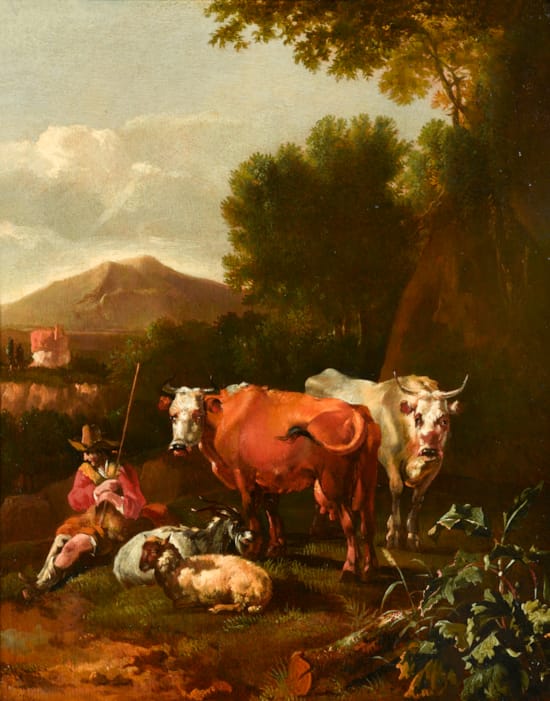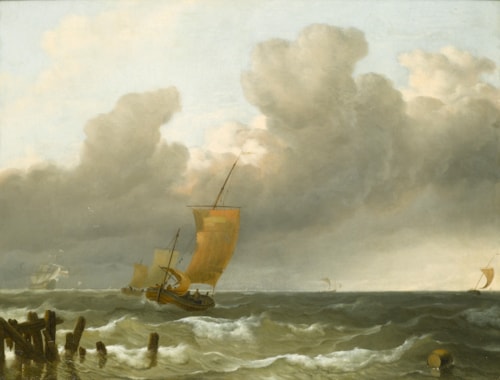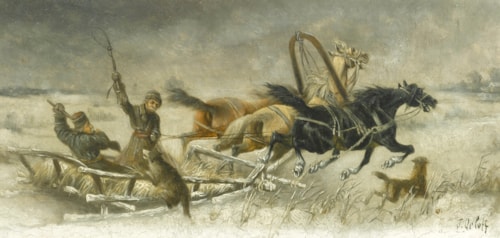braham Jansz. Begeyn
(Leiden 1637 - Berlin 1697)
An Italianate Landscape with a Herdsman and his Cattle Resting near a Tree
traces of a signature ‘AB’ (in ligature) ‘e...n.’ (lower left)
oil on panel
31.9 x 25.3 cm (12½ x 10 in)
This idyllic scene depicts a shepherd and his herd bathed in golden light at rest under the shade of a tree. The herdsman, lost in idle thought, is entirely oblivious to the viewer’s gaze; only the direct inquisitiveness of his two cows suggests intrusion upon this moment of very private solitude. The relaxed and lethargic posture of the human figure and the searing heat of the midday sun suggest that he intends to remain in the shade for some time longer. Lying nestled in the lush grass, the sheep take full advantage of this period of rest. Behind them, a simple cottage and a purple tinged mountain recede into the distance.
Both in style and subject matter the present work demonstrates a clear Italianate influence; Abraham Jansz. Begeyn has defined forms through bright patches of colour and intensive chiaroscuro. This is particularly evident in the plant in the foreground which, combined with the strong, golden light, evokes the heat of the day. Light is realistically rendered with bold colours in the foreground fading as the space recedes, lending the painting depth and perspective. Begeyn has also paid great attention to detail and texture, as is evident in the coats of the animals and the differing foliage whether oak leaves, blades of grass or young ferns.
A Dutch painter and draughtsman, Begeyn established his artistic career with paintings of Italianate harbour scenes dominated by richly dressed Dutch couples, lively animals and Oriental merchants. He then progressed onto landscapes, and in both genres the influence of his master, Nicholaes Berchem (1620-1683), a prolific member of the Dutch Italianates, is clearly manifest. Berchem’s landscapes often idealise rural life and are characterised by a receding background, varied and saturated colours, and a warm, southern light. Such trends, apparent in A Shepherd and Shepherdess with Flocks, are echoed in the present work and reveal the inspiration Begeyn drew from Berchem, although Begeyn’s direct arrangement of colours and uniform light distinguish his own personal style from that of his master.
In 1655, Begeyn became a member of the Guild of St. Luke in Leiden. He was registered in Amsterdam in 1672, but was shortly afterwards recorded in London, where he painted at Ham House, Surrey, together with Willem van de Velde the Younger (1633-1707) and Dirck van den Bergen (1645-1690). In 1681, he was in The Hague where two years later he became a member of the painters’ confraternity Pictura. From 1688, he was appointed court painter to Frederick III, Elector of Brandenburg, later Frederick I, King of Prussia. The Elector commissioned him to draw views of his country estates and of villages and towns in Germany.
Begeyn is noted mainly for his intricate views of villages and towns and for his southern seaports and Italianate landscapes. Later landscape compositions focussed more on the representation of ruins and architecture than figures making this present work a fine example of the former type of landscape painting he pursued.
Anonymous sale, Zurich, Koller, 27 November/1 December 1984, lot 5039;
With Robert Noortman, Maastricht/London, by 1986;
Offered, Amsterdam, Sotheby's, 1 June 1987, lot 63;
Private collection, The Netherlands.
This idyllic scene depicts a shepherd and his herd bathed in golden light at rest under the shade of a tree. The herdsman, lost in idle thought, is entirely oblivious to the viewer’s gaze; only the direct inquisitiveness of his two cows suggests intrusion upon this moment of very private solitude. The relaxed and lethargic posture of the human figure and the searing heat of the midday sun suggest that he intends to remain in the shade for some time longer. Lying nestled in the lush grass, the sheep take full advantage of this period of rest. Behind them, a simple cottage and a purple tinged mountain recede into the distance.
Both in style and subject matter the present work demonstrates a clear Italianate influence; Abraham Jansz. Begeyn has defined forms through bright patches of colour and intensive chiaroscuro. This is particularly evident in the plant in the foreground which, combined with the strong, golden light, evokes the heat of the day. Light is realistically rendered with bold colours in the foreground fading as the space recedes, lending the painting depth and perspective. Begeyn has also paid great attention to detail and texture, as is evident in the coats of the animals and the differing foliage whether oak leaves, blades of grass or young ferns.
A Dutch painter and draughtsman, Begeyn established his artistic career with paintings of Italianate harbour scenes dominated by richly dressed Dutch couples, lively animals and Oriental merchants. He then progressed onto landscapes, and in both genres the influence of his master, Nicholaes Berchem (1620-1683), a prolific member of the Dutch Italianates, is clearly manifest. Berchem’s landscapes often idealise rural life and are characterised by a receding background, varied and saturated colours, and a warm, southern light. Such trends, apparent in A Shepherd and Shepherdess with Flocks, are echoed in the present work and reveal the inspiration Begeyn drew from Berchem, although Begeyn’s direct arrangement of colours and uniform light distinguish his own personal style from that of his master.
In 1655, Begeyn became a member of the Guild of St. Luke in Leiden. He was registered in Amsterdam in 1672, but was shortly afterwards recorded in London, where he painted at Ham House, Surrey, together with Willem van de Velde the Younger (1633-1707) and Dirck van den Bergen (1645-1690). In 1681, he was in The Hague where two years later he became a member of the painters’ confraternity Pictura. From 1688, he was appointed court painter to Frederick III, Elector of Brandenburg, later Frederick I, King of Prussia. The Elector commissioned him to draw views of his country estates and of villages and towns in Germany.
Begeyn is noted mainly for his intricate views of villages and towns and for his southern seaports and Italianate landscapes. Later landscape compositions focussed more on the representation of ruins and architecture than figures making this present work a fine example of the former type of landscape painting he pursued.
Anonymous sale, Zurich, Koller, 27 November/1 December 1984, lot 5039;
With Robert Noortman, Maastricht/London, by 1986;
Offered, Amsterdam, Sotheby's, 1 June 1987, lot 63;
Private collection, The Netherlands.





 contact
contact contact
contact +44 20 7313 8040
+44 20 7313 8040









